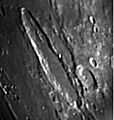Schiller (crater)
 Lunar Orbiter 4 image (black lines are artifact of image reprocessing) | |
| Coordinates | 51°48′S 40°00′W / 51.8°S 40.0°WCoordinates: 51°48′S 40°00′W / 51.8°S 40.0°W |
|---|---|
| Diameter | 179 × 71 km |
| Depth | 3.9 km |
| Colongitude | 39° at sunrise |
| Eponym | Julius Schiller |
Schiller is an oddly shaped lunar impact crater located in the southwestern sector of the Moon. To the east is the crater Bayer and to the southeast is Rost.
The rim of Schiller has an elongated shape that is amplified by its proximity to the lunar limb. The long axis lies along a line running northwest–southeast, with the wider girth located in the southeastern half. There is a slight bend in the elongation, with the concave side facing to the northeast. Schiller appears to be a fusion of two or more craters and bears a superficial resemblance to the footprint left by a shoe.
The crater rim is well-defined, with a terraced inner wall and a slight outer rampart. At the southeastern end, a smaller crater is connected to Schiller by a wide valley. Most of the crater floor is flat, most likely due to lava flooding. There are some bright patches that are most clearly visible under a high sun angle. A double ridge lies along the center of the northwest crater floor, forming a nearly linear formation that divides the floor in half.
Southwest of Schiller is an unnamed area of mare, possibly the remains of an ancient formation that has had its outer walls completely eroded away. This basin has received the unofficial designation 'Schiller Annular Plain' among lunar observers.[citation needed]
Views from Earth
References
- Wood, Chuck (2005-03-26). "A Long Crater". Lunar Photo of the Day. Retrieved 2006-07-12.
- Wood, Chuck (May 19, 2007). "Lavaflow Over a Low Nose?". Lunar Photo of the Day. Retrieved 2007-05-21.
- Andersson, L. E.; Whitaker, E. A. (1982). NASA Catalogue of Lunar Nomenclature. NASA RP-1097.
- Blue, Jennifer (July 25, 2007). "Gazetteer of Planetary Nomenclature". USGS. Retrieved 2007-08-05.
- Bussey, B.; Spudis, P. (2004). The Clementine Atlas of the Moon. New York: Cambridge University Press. ISBN 978-0-521-81528-4.
- Cocks, Elijah E.; Cocks, Josiah C. (1995). Who's Who on the Moon: A Biographical Dictionary of Lunar Nomenclature. Tudor Publishers. ISBN 978-0-936389-27-1.
- McDowell, Jonathan (July 15, 2007). "Lunar Nomenclature". Jonathan's Space Report. Retrieved 2007-10-24.
- Menzel, D. H.; Minnaert, M.; Levin, B.; Dollfus, A.; Bell, B. (1971). "Report on Lunar Nomenclature by the Working Group of Commission 17 of the IAU". Space Science Reviews 12 (2): 136–186. Bibcode:1971SSRv...12..136M. doi:10.1007/BF00171763.
- Moore, Patrick (2001). On the Moon. Sterling Publishing Co. ISBN 978-0-304-35469-6.
- Price, Fred W. (1988). The Moon Observer's Handbook. Cambridge University Press. ISBN 978-0-521-33500-3.
- Rükl, Antonín (1990). Atlas of the Moon. Kalmbach Books. ISBN 978-0-913135-17-4.
- Webb, Rev. T. W. (1962). Celestial Objects for Common Telescopes (6th revision ed.). Dover. ISBN 978-0-486-20917-3.
- Whitaker, Ewen A. (1999). Mapping and Naming the Moon. Cambridge University Press. ISBN 978-0-521-62248-6.
- Wlasuk, Peter T. (2000). Observing the Moon. Springer. ISBN 978-1-85233-193-1.

